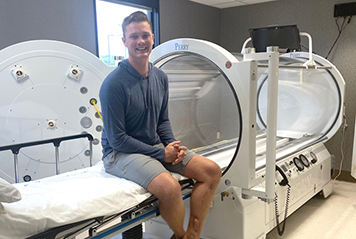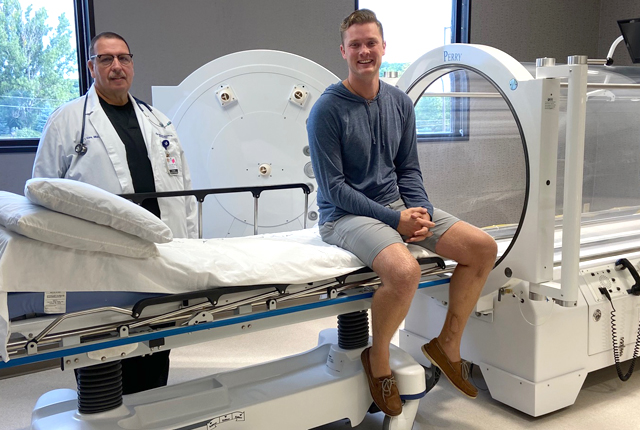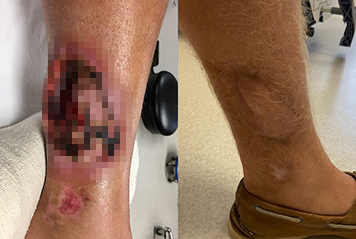Hyperbaric Oxygen Therapy for Wound Care
Colten Craigin wasn’t sure he would keep his leg.
Newly married, the active 28-year-old Indiana man was enjoying a snowmobile trip near his family cottage in Bear Lake, Michigan. When out of nowhere, he was struck by a car.
“I could hear the thud,” Colten said. “I could hear the glass shattering. And frankly, my bones shattering.”

Laying in the wreckage, doused in gasoline, and suffering severe internal injuries, Colten was rushed to Munson Medical Center to undergo a series of surgeries that would ultimately save his life. But his left ankle sustained a comminuted fracture – a bone break into multiple pieces. And saving his leg began another challenge altogether.
Colten’s surgeon, F. Matthew Smith, MD, FACS, of Great Lakes Plastic Surgery Center, elected to perform a left-radial forearm free flap – a procedure removing skin and soft tissue from Colten’s arm, moving it to his lower-leg, and connecting it using an operative microscope.
The skin graft survives if it’s placed on a new location that nourishes the tissue and enables blood supply. However, that was not the case for Colten. The lack of new blood vessel growth was depriving the tissue of healing oxygen and nutrients.
The flap needed to heal to avoid amputation. And it wasn’t looking good.
Hyperbaric Oxygen Therapy for Chronic Wounds
His life no longer at risk, Colten elected to recover in Bear Lake near Munson Healthcare Manistee Hospital. Surgeons monitoring his wound allowed it under one condition – he was to receive daily hyperbaric oxygen therapy (HBOT) treatments at the onsite Manistee Wound Care and Hyperbaric Center.
HBOT treatment is often used to treat stubborn wounds that won’t heal under standard care. Skin grafts and similar wounds need oxygen to heal properly, and HBOT provides 100% medical-grade oxygen in a closed chamber at pressure much greater than normal. Exposing wounds to these high oxygen levels can help them heal faster.
In Colten’s case, the HBOT therapy was last-chance therapy to supercharge his healing.
In a standard HBOT treatment, a patient lies still in the chamber anywhere from 90 minutes to two hours. The chamber is sealed and filled with oxygen at up to 2.5 times standard outside air pressure. After the treatment, technicians will slowly depressurize the chamber.
Some facilities have a large hyperbaric oxygen chambers that can treat up to a dozen people at once. But most hospitals, including Munson Healthcare Manistee and Munson Medical Center in Traverse City, offer monoplace chambers. These are HBOT chambers for just one person at a time.
Patients can’t bring anything inside the chamber, but technicians will help customize their environment during the therapy. Patients may speak with therapists or loved ones in the room at any time during treatment.
“Inside the chamber can be whatever you want it to be,” Colten said. “You’re in a glass tube. If you want it to be noisy with your music or your TV shows you can. If you want to take a nap, you can. It’s as loud or as quiet as you want.”
Patients might feel their ears pop during the pressurization, but Colten felt no ill-effects of the chamber treatments.

“At first it was a little scary, you get in there and they’re taking you down to pressure and you’re breathing all that saturated oxygen. I never got claustrophobic, but I can see how people could get worked up. However, the staff was great and I felt comfortable.”
Treatment length and frequency depend on the extent of the wound and how well it responds to therapy. Colten’s treatment required 2.5 hour sessions seven days a week.
It was extreme. And it worked.
HBOT Therapy Successfully Heals

Click to see the wound image prior to HBOT therapy.
“We initially anticipated treating Colten twice a day for the first three days with an additional fifteen or twenty days,” said Thomas Kane, FNP, WCC, Wound Care at Manistee Hospital. “But that turned into closer to 30 days. Specifically for skin grafts like Colten’s, hyperbaric therapy stimulates new blood capillary growth and increases oxygen in the tissue. It’s what keeps the skin viable until the graft is able to survive on its own.”
Colten knows his leg may never be back to 100% from his orthopedic injuries. However, the HBOT therapy provided his best possible outcome. He’s back to watersports and working full time as a medical sales representative for Stryker which is clearly a huge improvement from a potential amputation or the possibility of never walking again. And he needs all the mobility he can get while raising 9-month-old son, Jack, together with his wife of nearly three years.
“Manistee is lucky to have this technology,” Colten said. “The community needs to understand that you don’t have to go to a big city to get high quality wound care. It was really nice to have such advanced care that close to home.
“Every time I was wheeled to that building, everyone took care of me. They knew who I was and had everything prepared. I wasn’t just a number. The Munson Healthcare Manistee Hospital Wound Care program is amazing to have in our small community because you don’t get such a high level of care that often. I’ve worked in medicine all my life and I don’t say that often.”
Other HBOT Therapy Applications
HBOT therapy isn’t limited to just skin grafts. Other conditions ideal for this treatment include:
- Carbon monoxide poisoning
- Diabetic foot ulcers and related wounds
- Complications from a flesh-eating bacteria called necrotizing fasciitis
- Radiation injuries from cancer procedures
- Diving injuries and decompression injuries
- Bone infection called osteomyelitis
- Severe burns with grafts
- Non-healing C-sections, and more.
“Any wound that’s not healing and stuck at an inflammatory stage might be a candidate,” Kane said. “An open wound that hasn’t healed after two to three weeks should be looked at more closely. You should ask your primary care physician for a referral, but you can make an appointment with us and we’ll work with your doctor.”
HBOT for Chronic Wound Care Appointments
Munson Healthcare provides expert, comprehensive wound care. Without proper treatment, chronic wounds can become infected and may threaten the loss of limb or life.
If you have a wound that will not heal, talk to your doctor about a referral to the Advanced Wound Care and Hyperbaric Center in Traverse City or the Manistee Wound and Hyperbaric Center. Staff will be happy to discuss your case with you and your primary care physician.